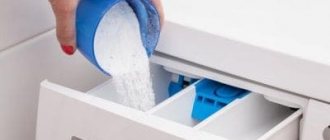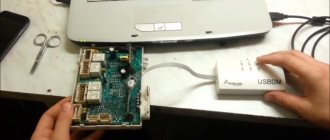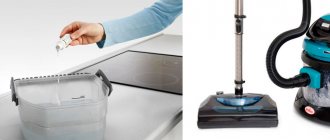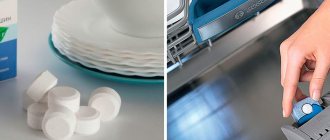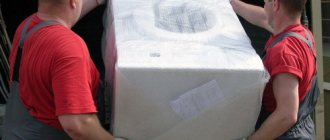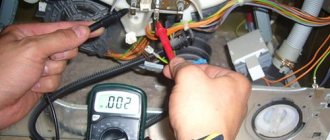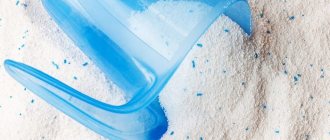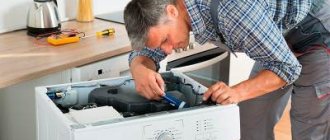Main stages
The washing machine disinfection procedure consists of the following steps:
- external cleaning;
- washing filter elements;
- descaling;
- removal of mold formations and unpleasant odors;
- cleaning from microorganisms.
Washing and removing dirt from the outside
Dry the machine with a soft cloth that absorbs water well. You can use liquid soap as a cleaning agent. Remove any remaining soap solution with clean water. Wipe the device with a dry cloth after cleaning.
See also
Composition and sizes of sponges for washing dishes, how often they need to be changed and which ones are better
Washing filters
Unscrew the drain filter, first placing a thick cloth under it. Wash it with heated water. If the dirt is not washed off, place the filter in a glass/plastic container for 3-4 minutes and pour in Domestos.
Descaling
It is possible to remove scale as follows:
- Pour 150 grams of citric acid into the powder compartment.
- Set the longest wash cycle at a temperature of about 92 degrees.
- Start the cycle.
Cleaning from mold and odor
Boiling is a simple and quick method of killing mold and eliminating unpleasant odors. When the water is heated to a temperature close to 100 degrees, the machine will be cleaned of mold formations. Activate the “boil” mode and start the cycle.
Disinfection from germs
It is possible to disinfect the device from germs using any of the following methods:
- Pour 200 grams of citric acid into the powder compartment.
- Pour 350 milliliters of table vinegar into the drum.
- Mix acetic acid in equal proportions with chlorine bleach and pour into the powder compartment.
- Mix 50 grams of soda with 50 milliliters of water, pour the solution into the cuvette. Pour a couple of glasses of vinegar into the drum.
Correct use of cleaning products
Cleaning the outside of the washing machine is done as follows. First of all, you need to dilute a little dishwashing detergent in a large amount of water.
Next, soak a cloth in this solution and wipe the front side of the washing machine with it, paying attention to the hatch door
Then use a dry cloth to wipe the washer dry. Next you need to process the glass of the hatch. A glass cleaner is suitable for these purposes.
The body of the washing machine cannot be cleaned with the following means:
- Dry powders;
- Abrasives;
- Substances containing chlorine.
The drain filter needs to be cleaned at least monthly. This is necessary to ensure that dirty water drains well from the machine. Regular cleaning of the drain filter also prevents unpleasant odors. This element of the machine can be found on the lower front panel of the washing machine. You need to unscrew it counterclockwise.
Before dismantling the filter, place a dry cloth under the device. After all, when you unscrew it, a small amount of water may leak out of the filter. The filter should be cleaned under water pressure using detergent. You can also disinfect it using Domestos.
The powder tray is a breeding ground for bacteria and even mold. Therefore, it must be washed without fail. To remove the tray, you need to press the latch, then gently pull it towards you.
A heavily soiled tray should be soaked in a solution of cleaning agent and water for a couple of hours, then cleaned with a toothbrush. To remove limescale, you need to use soda (calcined or baking soda). Then you can disinfect the tray using Domestos.
It should be noted that the powder receptacle must be cleaned and wiped with a dry cloth after each wash.
The powder receptacle opening must also be cleaned using a sponge and cleaning agent. After cleaning, wipe the tray dry with a cloth.
You can remove mold and remove foreign odors in the machine first with baking soda and then with citric acid. The first product is used to clean the drum of the device. To do this you need to take a soft sponge. Use it to apply lightly moistened soda to the washer drum. The inside of the cuff can be treated in the same way.
The cuff should be pulled apart during cleaning. About an hour after applying the product, you need to clean the washer drum and cuff with a sponge. Then you should rinse well and then wipe dry the cleaned sides of the above parts of the washing machine.
Acetic acid removes odors and kills germs. But after using it, there will be a specific smell in the car. Rinsing with conditioner will help eliminate it.
The most important procedure is to disinfect the washing machine from the inside. It allows you to get rid of viruses, kill all bacteria and destroy fungus. Disinfection of washing equipment can only be done using special means.
These products include chlorine, as well as products made on the basis of chlorine. However, chlorine should only be used in exceptional cases. For example, when you need to overcome a virus or infection. In other cases, it is recommended to use other, more delicate methods of disinfection.
For example, you can use various oxygen-containing bleaches:
- Vanish;
- Velvet;
- Belle;
- Synergetic.
These products have disinfectant properties. You need to add bleach during normal washing.
To clean parts from scale, rid them of mold and defeat bacteria, you must use:
- Dr. Beckman;
- Cleaning agent SANDOKKAEBI;
- Means Doctor TEN Antibacterial.
Review of professional products
Of the professional disinfection products, the most effective are:
- Dr. Tan Antibacterial;
- Dr. Beckman;
- SANDOKKAEBI;
- Multidez-Teflex.
Dr. Teng Antibacterial
This product allows you to remove scale from your washing machine and disinfect it. Promotes quick and effective removal of lime from the drum and heating element. The product contains no acids, therefore, the elements of the machine, which are made of metal/plastic/rubber, will not break.
Dr. Beckman
The liquid product Doctor Beckman has a bluish color and has a specific odor. It includes:
- tenside neitones;
- flavoring;
- hexylcinnamal.
The cleaner in powder form has a slightly different composition:
- zeolites;
- oxygen-based bleach;
- flavoring;
- limonene;
- hexylcinnamal.
See also
How to clean your computer from dust at home, step-by-step guide
Dr. Beckman provides:
- protection of metal parts of the machine from corrosive effects;
- elimination of large contaminants;
- elimination of mold formations in the drum, heating element, pipeline;
- extension of the operational period.
SANDOKKAEBI
This Korean product allows you to clean the drums of washing machines with vertical/front loading. The product is good at removing hard water deposits. It is sold in half-kilogram packs.
Multidez-Teflex
This disinfectant is made in the Russian Federation. It has an antimicrobial effect and also destroys viruses. On surfaces treated with it, an almost invisible film is formed, which provides a residual antimicrobial effect. Multidez-Teflex does not provoke corrosion of metal parts.
Do-it-yourself disinfection of a washing machine
Places where water often accumulates in the washing machine provide excellent conditions for the development of microorganisms, especially in the tank, filter, under the sealing collar and in the detergent tray. Timely cleaning and periodic disinfection of the machine helps to avoid problems with their appearance and development.
How to disinfect a washing machine:
- Washing the outside of the unit and removing dirt and plaque;
- Filter washing;
- Removing scale and salt deposits;
- Getting rid of unpleasant odors and mold;
- Work on disinfecting the washing tank.
Cleaning the outside of a washing machine involves washing and wiping the outer panels with a soft-lint cloth soaked in a solution of water and dishwashing detergent. The loading hatch and the front wall are subject to treatment.
After wiping, wipe the surfaces dry with a dry, clean cloth. The dirty glass of the loading hatch door can be washed using glass cleaning products.
Important: do not use abrasive substances or dry powders containing chlorine to clean the washing machine.
To prevent the appearance of an unpleasant odor and deterioration of the drain system, it is necessary to periodically wash the drain filter, at least once a month. Typically the filter is located at the bottom of the front of the machine. The decorative cover is unscrewed in the direction opposite to the clockwise movement.
There is some water remaining under the filter cover, so before opening it, you need to place a water container and a rag. The filter is washed with detergent in running water. To disinfect the filter, Domestos can be added to the water.
The detergent container is constantly at risk of mold and bacteria growing in it. It should be removed by pulling the special latch and the tray should be washed in water. If the contamination is strong, then before washing, you need to soak it for 1-2 hours in warm water with a detergent.
After soaking the dirt, it is removed with an unnecessary toothbrush. If there is a yellow coating in the container, you should use soda. You can use both food grade and calcined. Or, you can use Domestos dissolved in water.
The tray must be washed and disinfected after each wash. The hole in which it is located also needs to be cleaned periodically, as powder particles regularly remain in it.
Baking soda and citric acid help get rid of the unpleasant odor that often appears inside the car. The drum and sealing collar can be cleaned with soda by applying it to a damp sponge. The drum is wiped with a sponge, and before cleaning the cuff must be slightly pulled apart and a soda solution applied to its surface. After half an hour or an hour, wash the cuff and drum with the same damp sponge, and then wipe them dry with a clean cloth.
Acetic acid also copes successfully with odors and microorganisms. The disadvantage of this type of cleaning is that the persistent smell of vinegar will remain in the washing machine for a long time. You can get rid of the vinegar smell by rinsing with conditioner for a long time.
Disinfecting a washing machine from the inside is disinfection from fungus, viruses, bacteria and various microorganisms. Only chlorine-containing or chlorine-based products can cope with infections. Many people clean their cars with Beliz, Domestos, ACE and others.
However, experts do not recommend using them often, and using chlorine only in extreme cases, when there are real signs of infection, viruses or fungi. There are easier, but still effective methods for carrying out routine disinfection.
What modes will help during the washing process?
Washing at elevated temperatures itself already disinfects the machine. Most microbes die at temperatures above 60 degrees.
So, for disinfection, you can activate the “synthetic 60” or “cotton 60” mode. This will get rid of dust mites and other microorganisms.
“Antibacterial” mode is provided in modern machines. With it, the water is heated to 80 degrees, the set temperature is maintained for at least 20 minutes.
Disinfection of the machine
The component parts of the machine have a favorable climate for the appearance of microbes.
This especially applies to places where water accumulates:
For this reason, you need to clean your washing equipment regularly.
Disinfection of the washing machine contains the following points:
- Cleaning the external parts of the washing machine;
- Destruction of microbes;
- Cleaning filters;
- Cleaning the device from foreign odors;
- Removing scale and mold deposits.
What does disinfection of a washing machine consist of?
The machine is constantly in contact with various detergents, so a large layer of scale forms on the heating element. This is fraught with the appearance of an unpleasant odor, and fungus may appear. Disinfecting your washing machine is an excellent way to prevent infection, eliminate germs and bacteria that most often live in the powder receptacle, rubber seal, filter and drum. If you neglect to clean the machine, germs penetrate the laundry loaded into the drum. This leads to irritation on the skin even from washed clothes. Let's look at some recommendations on how to disinfect a washing machine:
- Regularly wash and remove dirt from the outside of the SMA.
- Wash the filter.
- Disinfect the washing machine using special products.
- Wipe the external parts with a dry cloth after each wash.
- Eliminate mold and unpleasant odors immediately after they are discovered.
Important! By listening to the recommendations, you will notice that the washing machine will work properly and efficiently. This guarantees an increase in service life by several years.
